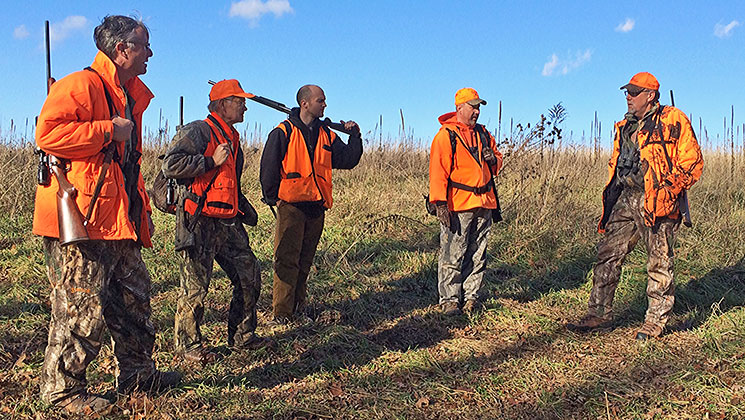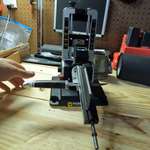
With the three-hour mooch complete on a recent December morning, our six-pack of deer hunters chewed venison sticks in Doug Duren’s old farmhouse in southwestern Wisconsin and wondered where Duren would send us for the afternoon mooch.
Any outsider listening in probably would’ve wondered about something else: “What’s a ‘mooch’ and how does it involve deer hunting?” Good question. No dictionary explains the term the way Duren uses it. Mooching does not mean loitering, which assumes you’re hanging around with no purpose. Nor does it involve begging for food, drink, money or other handouts.
Instead, one mooches by moving glacier-like along a precise route, as designated by Duren, through a woodlot or its border with a field of corn or alfalfa. Your individual mooch, when combined with mooches made by fellow moochers, creates one overall mooch, much as individual drivers combine to create a drive.
If the mooch succeeds, a moocher gets a shot at a slow-moving deer, or nudges it past a waiting hunter who Duren has appointed to a stand. In other words, moochers do what Duren dictates at speeds somewhere between loitering and walking.
Good moochers who do as they’re told might one day be assigned a stand. And there they’ll wait at least two hours, but usually more, trusting the moochers to not hurry the process. The moocher’s job is to quietly urge deer onto their hooves and to the nearest trail, kind of like how you slink into the next grocery aisle when the town bore looms ahead but hasn’t seen you.

What's a Mooch?
In other words, a “mooch” is a slow-motion deer drive usually done by small hunting groups using the wind, cover and terrain to slowly move deer along regularly traveled trails to other hunters. Duren isn’t sure how or where the term originated, but suspects it’s linked to his Uncle Ralph, who carried an open-sighted .30-40 Krag to hunt deer in the Chequamegon National Forest in northwestern Wisconsin. Duren never saw a deer in that vast forest until Uncle Ralph shocked him by shooting a young buck while “mooching around” on his own.
The term and its meaning apparently were rooted in that region, because it also described a successful 1950s-era hunt immortalized in a Gordon MacQuarrie story, “You’ve Got to Suffer!” In the autobiographical account, a heavy snow had smothered northwestern Wisconsin as opening weekend approached. When MacQuarrie’s father-in-law asked him to make “one little drive,” Mac initially refused, saying, “I’m not mooching in this snow.”
MacQuarrie relented when “Mr. President” told him to grab a pair of snowshoes from the cabin wall and wear off some of their varnish. Soon after, MacQuarrie was nudging a deer toward the “Old Man,” much in the manner Duren dictates when hunting farmland deer nearly 70 years later and 200 miles to the south.
MacQuarrie wrote: “The deer was moving ahead of me. Buck or doe? I do not know. Even in fresh mud I do not know, and I think that no one else can tell for certain. … This deer was not plunging. It seemed to know my pace and kept just ahead of me. Likely it had heard me when I was a hundred yards away from it, and had got up quietly and just sneaked away from me. … Deer can be very contemptuous of a man.”
Unfortunately, the Old Man never saw that deer because he fell asleep while waiting on a stump, dressed too warmly in heavy clothing and “huge aviator’s boots.” When MacQuarrie strapped on his snowshoes the next day to try again, the Old Man intentionally dressed too lightly and returned to the stump. This time he shot the buck as it again moved just ahead of MacQuarrie, and explained his success: “You got to suffer first.”

Maintain Discipline
Duren doesn’t demand his hunting partners suffer. He does, however, expect everyone to listen to his instructions and follow them. To ensure understanding, he keeps a large aerial photo of his 400-acre farm pinned to a bulletin board near the farmhouse’s kitchen. During his pre-mooch briefings, Duren wields a yardstick and taps out assignments on the photo. He identifies each stand by name with a post-it, and traces each mooching route with the yardstick.
Before explaining his plans and making assignments, Duren consults his smartphone for wind and weather forecasts. After using that information to craft his plan, he gives the mooch’s objective while specifying each hunter’s role. His briefings go something like this: “The wind’s from the northwest, so I’ll take Durkin and Stan over to the McGlynn farm. We’ll put Stan in the cornfield blind, and then Durkin and I will separate and circle south through the creek bottom. Then we’ll head east up the hill so our scent blows into the woods ahead of us. Durkin will follow the woods north while I go east to meet Hans.”
Tapping the photo for emphasis, Duren jabs the yardstick at a wooded peninsula with an elevated box stand: “Dan, you’ll sit here. When Durkin reaches the far hilltop, Stan will leave his stand and follow the lower field while Durkin follows the upper field. Hans and I will wait across the upper field until Durkin reaches the northeast corner. Then we’ll let our scent blow through the pine plantation before moving north toward you.”
Turning to another hunter, Duren raps the photo again and says: “Kief, you wait down here behind the barn in case anything squirts out the side. If this works, we’ll move some deer past Dan before we wrap up. Okay. It’s 8 o’clock now. Take extra clothes if you’re a stander. This will take almost all morning.”
Duren sees several advantages to mooching deer, rather than driving them. Yes, he prefers not to send deer fleeing into neighboring woodlots, but his greater goal is a safe hunt and easy shots.
“In a traditional drive—where you post a line of blockers and send in a second line of drivers to sweep the woods—deer come out of there belching fire and hauling the freight,” Duren says. “It’s hard to get a good, safe, ethical shot. With a mooch, deer get up and start moving, but it’s almost like a rabbit being chased by beagles. They sometimes just get up, circle the block to lose you and settle back down. If they keep going, by the time they reach the standers, they’re moving slowly. That makes a much better target. And if they circle back or go out the side past a moocher, you usually have time to size up things for a safe shot. If you’re not sure, you don’t shoot.
“It’s a fun, relaxing way to hunt,” Duren continues. “Every mooch is different, depending on the group, the wind and time of day. You don’t just run through a bunch of set drives that you—and the deer—both know.”
Avoid Accidents
Duren emphasizes safety because he knows the potential dangers of deer drives, especially in states like Wisconsin with short (nine days) firearm seasons and more than 600,000 licensed hunters. A recent review of 10 consecutive Wisconsin gun seasons found more than half of the state’s shooting accidents involved hunters who knew each other. Specifically, of 181 gun-season shootings from 1997-2006, 97 (54 percent) involved members of the same group, and 67 (37 percent) were self-inflicted. During that 10-year period, drives accounted for 70 of the 181 shooting accidents (39 percent) and eight (33.3 percent) of the state’s 24 fatal woundings. Further, about 70 percent of shootings involving other people occurred as a deer ran or walked.
Why do drives produce disproportionate numbers of shootings? For starters, a running deer presents a moving target, and shooters can’t carefully inspect the ever-changing backdrop. A hurried shooter might never see another hunter beyond the deer.
Plus, hunters often feel pressure to fill their tag as the season winds down. Deer activity plummets once the game realizes it’s being hunted, and nothing gets the deer moving more reliably than hunters busting through brush, woodlots, dry marshes or standing corn. When a deer bursts from cover and the hunter’s adrenaline surges, the shooter may experience the “tunnel vision” phenomenon. That is, when humans experience extreme fear or excitement, they can focus so intently on an objective that they block out their peripheral vision.
People in the shooter’s sight line can break through that tunnel vision by wearing hunter-orange clothing, which the human eye easily detects. Hunters who wear faded orange clothing, or remove or obscure blaze orange when afield, might think they’re less visible to deer, but there’s no doubt they’re less visible to other hunters.
For safety and other reasons, Duren plans each mooch with patient precision, which sets the tone for all participants. They understand their roles and how they mesh with the roles everyone else is assigned. He also doesn’t pressure his friends and family to fill tags, even though he usually wants to reduce the farm’s antlerless deer population.
“Our objective isn’t to just kill deer,” Duren says. “We want a productive hunt, but it must be safe. When you read about hunting accidents, the hunters often say their group is safe, and they never had a problem before. That’s all well and good, but you’re only as safe as your next hunt.”
That approach underscores what investigators often find when studying shootings on deer drives: poor leadership and planning. “If you don’t plan your drives to be safe, they won’t be,” Duren notes. “Even then, everyone might know where they’re supposed to be, but you can’t assume everyone will be exactly where you send them. Basic safety rules still apply. Be sure of your target and beyond. You must know your safe-fire zone.”

Better for Big Bucks
Finally, a well-planned, well-executed mooch provides another benefit for those hunting well-managed properties: A mooch is more likely than a traditional drive to fool a mature buck.
“Older bucks have survived a minimum of three gun seasons, so they aren’t likely to jump up and fly away over the hill with a bunch of young deer,” Duren says. “They’re more likely to try sneaking away, or sit tight and let you move past. By moving slowly like they’re still-hunting on their own, moochers who take their time and pay attention have as good of a chance as anyone to kill that buck. And if they don’t see it, the buck will probably just lie down nearby, and never leave the property.”
Whether you call it a mooch or define it as a slow-motion drive, you should achieve the same results if you do it right. You and your group will enjoy safe, relaxed, productive hunts that let deer think they’re quietly escaping along well-tested routes. With a little luck, the trail they choose will lead to your success.



































